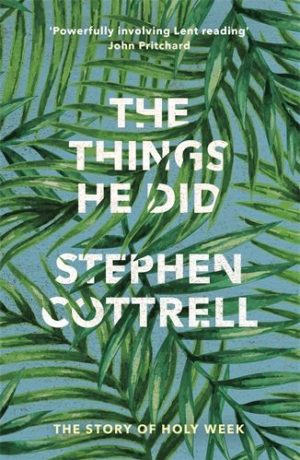



This is a book about everything that happens in Holy Week up until the crucifixion. It finishes where many other Holy Week books start.
Many biblical commentators say that the best way of understanding Jesus’ ministry is by focusing on what he did rather than what he said; and even when he does speak his words are reflections on his actions.
This is particularly true of Holy Week. Jesus stands in the prophetic tradition of those who embody and act out what they teach. He does things. He creates an impact. His entry into Jerusalem on a donkey, for instance, so often thought of as a sign of his humility, is actually a deliberate and politically and religiously provocative act, intentionally acting out the prophecy of Zechariah. Those who knew the Scriptures would have known what was intended.
Overturning the tables of the money lenders can also be read as a means of disrupting the legitimate business of the Temple in order to make the point that the Temple is no longer needed. Washing feet is a sign of a new and different sort of leadership. And so on.
Two of my previous Holy Week books, The Things He Carried and The Things He Said, focus on Good Friday and Easter. This book completes the story by looking at these other events in Holy Week that lead up to Good Friday. Each chapter focuses on a different event in the story and brings out the political and religious significance as Jesus moves towards his greatest and final act – his death and resurrection.
These key events of Holy Week – his entry into Jerusalem, his overturning the tables in the Temple, washing his disciples’ feet, and particularly breaking bread with them at the Passover– provide the hermeneutical key for what his death and resurrection mean. His words at the Last Supper about his body broken and blood shed would have made little sense until after the crucifixion and the resurrection. But then they become the means by which these events are understood and celebrated.
After the Last Supper Jesus prays to the Father that the cup he is being asked to drink might be taken from him, that there might be another way. With the arrest that follows, this event, often referred to as ‘the agony in the garden’, is a natural conclusion to that stage of his ministry where he is doing things. From this point onwards– as he receives the cup – he allows himself to be handed over so that things are done to him. This is the meaning of the Passion – both to suffer, but also to become passive, one who is done unto. This is what he carries to the cross – the things we give him, the things we do to him, the things he carries for us, the things God asks of him, and the cup he has to drink. The weight of the cross and all that Jesus carries is explored in the second book, The Things He Carried. Forming a trilogy, the story concludes with the things that he says on Easter Day, The Things He Said. These penetrating words of comfort and enquiry complete the story and point forwards to the new life of resurrection. This book, although written last, completes the trilogy by beginning it.
There is also a link between what is explored in this book and the worship of the Church in Holy Week, particularly the liturgy on Palm Sunday and Maundy Thursday. I hope that those reading the book during Lent will, therefore, be better prepared for Holy Week. If the book is studied in a group there are questions after each chapter to facilitate discussion and reflection.
Most of all I hope the book, like those that preceded it and follow its journey, will take you inside the story of what God has done for us in Christ, the sorrows that he carried for us, the things that he said to us, and here, in this book, the things that he did, so that we can see who God is and what our humanity could be.
Finally, I am pleased to be able to include the story of the woman who anoints Jesus at Bethany in the house of Simon the Leper (Matthew 26.6–13). Matthew’s account of this story ends with the words, ‘Wherever this good news is proclaimed in the whole world, what she has done will be told in remembrance of her.’ Unfortunately, the Church’s Holy Week lectionaries seem to have overlooked this promise. Far be it from me to suggest that this could be because, generally speaking, lectionaries are compiled by men! But this vital story, telling of what this woman does to Jesus out of her love for him, and in anticipation of his death, and of his acceptance of her (and by association of all who in being served are able to serve others), is missed out. But, surely, this story illustrates the meaning of the things that Jesus did. Having washed his disciples’ feet he says to them: ‘So if I, your Lord and Teacher, have washed your feet, you also ought to wash one another’s feet. For I have set you an example, that you also should do as I have done to you’ (John 13.14–15).